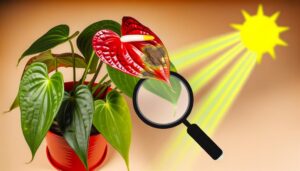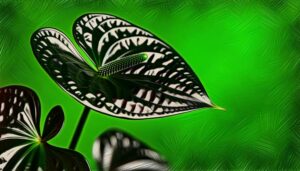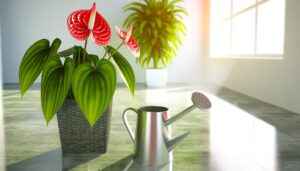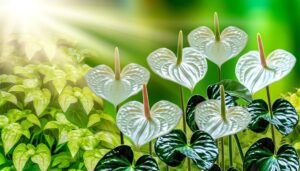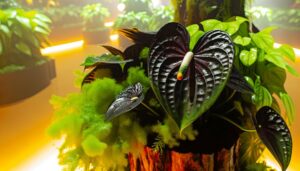Unique Traits of the Bali Red Anthurium
You'll find the Bali Red Anthurium striking for several reasons. Its vibrant red spathes feature intense pigmentation and a glossy, lacquered surface due to anthocyanin pigments and a waxy cuticle layer.
The heart-shaped leaves are deep green, with high chlorophyll density and prominent venation, optimizing photosynthesis and nutrient transport. These leaves also have undulating margins and strong petioles, adapting their morphology based on light exposure.
For care, use a well-draining mix, maintain humidity above 60%, and provide indirect sunlight. Balanced bi-monthly fertilization and pest control are essential.
Continue to explore how its resilience and growing conditions enhance its beauty.
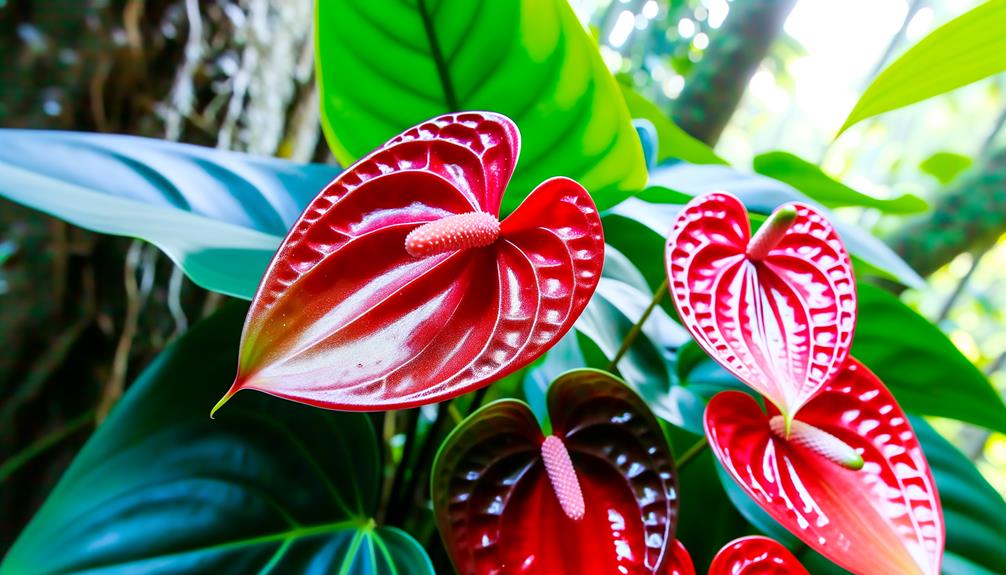
Key Takeaways
- Bali Red Anthurium features vibrant red spathes with intense pigmentation from anthocyanin pigments.
- The plant has glossy, heart-shaped leaves with a thick waxy cuticle, enhancing durability.
- Its leaves exhibit unique chlorophyll density, ensuring efficient photosynthesis.
- The resilient plant adapts its leaf morphology in response to environmental conditions.
- Optimal growth requires bright, indirect sunlight and humidity levels above 60%.
Vibrant Red Spathes
The vibrant red spathes of the Bali Red Anthurium are characterized by their intense pigmentation and glossy texture, making them a standout feature in any botanical setting.
You'll notice that the spathes exhibit a rich, crimson hue due to anthocyanin pigments, which are responsible for the plant's striking coloration. These pigments absorb specific wavelengths of light, intensifying the red shade, particularly under direct sunlight.
The spathes exhibit a smooth, almost lacquered surface, enhancing their visual appeal and creating a reflective sheen. This glossy texture results from a waxy cuticle layer that reduces water loss and offers a barrier against pathogens.
Glossy Heart-Shaped Leaves
You'll immediately notice the Bali Red Anthurium's shiny heart-shaped leaves, which boast a rich, deep green hue and a smooth, reflective surface. These leaves possess a unique chlorophyll density, maximizing photosynthesis efficiency. Their thick, waxy cuticle layer not only imparts that striking shine but also reduces water loss via transpiration, perfect for humid environments. The venation pattern, prominently visible, provides structural integrity and efficient nutrient transport.
As you examine further, you'll observe the leaves' subtle, undulating margins, which enhance their aesthetic appeal. The petioles, strong and slightly arched, anchor these leaves securely, ensuring ideal light capture. Each leaf's curvature creates an enchanting interplay of light and shadow, inviting a closer, more intimate inspection of this botanical marvel.
Growth Habits
When examining the growth habits of the Bali Red Anthurium, you'll notice distinct leaf shape variations that respond to specific environmental conditions.
Best light exposure significantly influences these morphological changes, affecting both the size and structure of the leaves.
Understanding these factors allows for precise cultivation practices tailored to this unique species.
Leaf Shape Variations
Leaf shape variations in the Bali Red Anthurium exhibit distinct growth habits influenced by environmental conditions and genetic factors. You'll notice these variations as the plant matures, adapting its leaf morphology to enhance resource acquisition. The leaves can range from elongated to heart-shaped, reflecting their adaptive strategies.
| Leaf Shape | Description |
|---|---|
| Elongated | Narrow, increasing surface area |
| Heart-shaped | Broad base, best for light capture |
| Oval | Intermediate, balanced resource intake |
You can observe that elongated leaves are ideal for maximizing surface area, while heart-shaped ones excel at light capture. The oval shape serves as a balanced compromise. These morphological traits are essential for the plant's survival, showcasing its remarkable adaptability to varying conditions.
Optimal Light Conditions
Understanding the most suitable light conditions for the Bali Red Anthurium is crucial for fostering its unique growth habits and promoting its vibrant foliage. You'll want to provide bright, indirect light, as direct sunlight can scorch its leaves.
Consider these points:
- Light Intensity: Aim for a light level of around 10,000-20,000 lumens. This mimics the dappled light of its natural habitat under the forest canopy.
- Duration: Maintain about 12-14 hours of light exposure daily, balancing between natural daylight and artificial grow lights if necessary.
- Positioning: Place your Anthurium near an east-facing window to capture gentle morning light, avoiding harsh afternoon rays.
Following these guidelines promotes optimal photosynthesis, encouraging vigorous growth and intense, red pigmentation in its leaves.
Resilience and Care
The Bali Red Anthurium thrives due to its remarkable resilience, requiring specific care techniques to maintain its vibrant health and striking appearance. You should monitor its root structure regularly to prevent rot, as excess moisture can be detrimental.
Employ a well-draining potting mix to facilitate adequate aeration. Prune dead leaves meticulously to redirect energy towards new growth. Utilize balanced, water-soluble fertilizers bi-monthly to supply essential nutrients without overwhelming the plant.
Observe for common pests like aphids and scale insects, treating infested areas with neem oil or insecticidal soap. Maintain humidity levels between 60-80% to mimic its native tropical environment, ensuring the plant's cellular functions remain at their best.
Consistent, thoughtful care will sustain your Anthurium's resilience and allure.
Ideal Growing Conditions
To guarantee ideal growth, position your Bali Red Anthurium in bright, indirect sunlight to mimic its natural tropical habitat. This plant thrives in humidity levels above 60% and requires well-draining soil to prevent root rot. Maintain a consistent temperature range between 70-85°F to ensure best metabolic processes.
Consider the following key factors:
- Light: Place it near an east-facing window, making sure it receives diffused light without direct sun exposure.
- Water: Water when the top inch of the soil feels dry; avoid overwatering to prevent fungal infections.
- Humidity: Use a humidifier or pebble tray to enhance moisture levels, particularly in dry climates.
Popularity Among Gardeners
Drawing attention for its striking red spathes and lush foliage, the Bali Red Anthurium has become a favorite among gardeners seeking both aesthetic appeal and tropical flair in their plant collections.
You'll appreciate its vibrant pigmentation, which results from anthocyanin accumulation, enhancing visual interest.
This species' adaptability to indoor environments and moderate humidity levels makes it particularly appealing.
Its inflorescence, characterized by a vivid spadix and spathe, serves as a focal point in any botanical arrangement.
Additionally, the plant's robust root system guarantees longevity and resilience.
Conclusion
Imagine the Bali Red Anthurium as a jewel in your garden's crown. Its vibrant red spathes symbolize passion, while the glossy heart-shaped leaves reflect love and dedication to nature.
With proper care, this resilient plant flourishes, much like a well-tended relationship. Its unique growth habits and ideal conditions underscore the meticulous attention it demands.
As a gardener, nurturing this botanical gem means embracing both the science and artistry of horticulture, ensuring a lush, thriving sanctuary.

